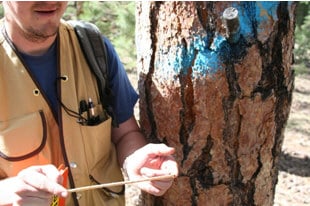
Much ado is being made about the Colt Summit logging and restoration project on the Lolo National Forest. In fact, last week The Wilderness Society, Montana Wilderness Association, National Wildlife Federation and Yaak Valley Forest Council joined with the Montana Logging Association, Montana Wood Products Association and others to actually file a “friend of the court” brief in support of this logging project.
Asking around, this appears to be the first time that conservation groups like The Wilderness Society, Montana Wilderness Association and National Wildlife Federation have filed a brief to support a logging project. Reading the rhetoric-filed, dooms-day press releases from these folks, you can’t help but get the impression that the Lolo National Forest must be under siege from timber sale lawsuits.
However, the facts tell a much different story.
Lolo National Forest officials confirm that the Lolo National Forest hasn’t faced a new timber sale lawsuit in over 5 years. In fact, between FY 2005 and FY 2010, the Lolo National Forest had at least 99 active timber sales.
Another impression one gets from reading press releases and statements from these groups is that the Colt Summit lawsuit has halted the positive road decommissioning and culvert upgrade work. In fact, the Montana Wilderness Association even has gone so far as to tell their members and supporters via Facebook that what’s “at stake” with the Colt Summit project is the road decommissioning/culvert work.
[Update: An hour after this article was posted, Montana Wilderness Association staffers removed these (here, here) substantive comments from their Facebook posts about the Colt Summit timber sale. Such tactics have been a very common practice by these groups as they attempt to stifle debate and prevent the open exchange of substantive information.]
Perhaps the people at Montana Wilderness Association should have more carefully read the plaintiffs summary judgment brief in this case:
“CONCLUSION
Wherefore, Plaintiffs respectfully request this Court grant their motion for summary judgment, declare the Forest Service violated the law, and enjoin the Forest Service from approving and/or authorizing work on the Colt Summit project (excluding the road decommissioning and culvert removal work) pending full compliance with the law.”
Perhaps the staffers at Montana Wilderness Association should have remembered that last September, the Lolo National Forest issued this press release, very clearly (and somewhat ironically) titled “Colt Summit Restoration Contracts Awarded.”
In fact, below I will re-print an update about the status of the Colt Summit road decommissioning and culvert upgrade work I obtained over the past few days from the Boyd Hartwig, the Lolo National Forest’s very own Public Affairs Officer. Boyd’s generally been pretty good about responding to pubic information requests and as anyone can clearly see, the Lolo National Forest confirms that the following restoration work has been under contract since last September, is moving forward and is not impacted by the lawsuit.
1. Colt Creek Road Decommissioning will decommission about 6 miles of Colt Creek Road #646.
2. Colt Creek Road Rehabilitation will reconstruct an existing road to BMP standards and add a short section of newly- constructed road. This route will replace access currently provided by road #646. It’s important to note that the short piece of new construction is not being funded through CFLR.
3. Colt Creek Culvert Replacement project will replace an undersized culvert with a new structure that provides for aquatic organism passage.
So there you have it folks. A pretty good, verified example of how much of the rhetoric and the “story-line” coming from these “collaborator” organizations and their timber industry “partners” isn’t really matching up too great with the reality of the situation on the ground, or in the courtroom. I believe there are a number of reasons for this, and perhaps in coming days I will get an opportunity to explore them further on this blog. However, suffice to say, it shouldn’t be lost on anyone that what we’re seeing with the Colt Summit timber sale PR blitz from these “collaborators” is really just a continuation and/or extension of the campaign to support Senator Tester’s mandated logging bill, the Forest Jobs and Recreation Act. The players, political campaign type tactics/rhetoric and the intentional spreading of false information about these public lands issues is virtually identical.
From: Matthew Koehler
Sent: Thursday, March 01, 2012 12:47 PMHello Boyd:
Can you please tell if this work [Lolo NF Press Release, September 30, 2011] is on-going or finished? Also, can you let me know details of all the work currently being done, or under contract, in the Colt Summit project area? Thank you. – Matthew
—————–
From: Boyd Hartwig
Matthew, all three projects are awarded. No ground disturbing activity has occurred to date. Ground-based activity could begin as early as July 1, 2012. Instream work associated with the culvert replacement project must occur between July 15 and Sept. 1. The decommissioning work cannot be done until alternative access is provided through the Colt Creek Road Rehab project.
Boyd Hartwig
Public Affairs Officer
Lolo National Forest——————
From: Matthew Koehler
Sent: Monday, March 05, 2012 12:38Hello Boyd:
Thanks so much for the info. Just so I have it correctly can you please confirm the following:
1) The name of these three projects awarded, or at least what work is included in this
2) That the lawsuit filed on Colt Summit hasn’t stopped these three projects from moving forward.
Thanks so much,
Matthew Koehler———————-
Date: Mon, 5 Mar 2012
From: Hartwig, Boyd C -FS
To: Matthew Koehler <[email protected]>Matthew, here are the listed projects:
1. Colt Creek Road Decommissioning will decommission about 6 miles of Colt Creek Road #646.
2. Colt Creek Road Rehabilitation will reconstruct an existing road to BMP standards and add a short section of newly- constructed road. This route will replace access currently provided by road #646. It’s important to note that the short piece of new construction is not being funded through CFLR.
3. Colt Creek Culvert Replacement project will replace an undersized culvert with a new structure that provides for aquatic organism passage.
All three projects are awarded but no ground disturbing activity has occurred to date. Instream work associated with the culvert replacement project must occur between July 15 and Sept. 1. The decommissioning work cannot be done until alternative access is provided through the Colt Creek Road Rehab project.
Regarding start dates, they are hoping to begin work this spring, that’s correct. They are aware of the lawsuit but as you know there is no injunction on the planned work.
Boyd Hartwig
Public Affairs Officer
Lolo National Forest





